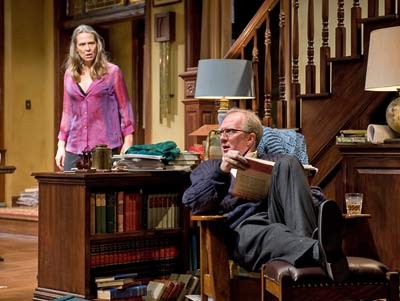Virginia Woolf at Chicago's Steppenwolf
Tracy Letts and Amy Morton Star To Feb 13
By: Susan Hall - Dec 27, 2010
Who's Afraid of Virginia Woolf
by Edward Albee
Directed by Pam MacKinnon
Steppenwolf Theater Company, Chicago
Amy Morton, Martha
Tracy Letts, George
Madison Dirks, Nick
Carrie Coon, Honey
Scenc Design by Todd Rosenthal, Costume Design, Nan Cibula-Jenkins, Lighting Design, Allen Lee Hughes, Sound Design, Rob Milburn and Michael Bodeen, Fight Choreography, Nick Sandys.
Through February 13
Who's Afraid of Virginia Woolf is a play of words and in the new Steppenwolf production they are delivered by great actors with infinite variety and insight.
Words can be the obvious weapons -- they hurt, deflect and rebuff. They can also create fantasy and provide comfort. Albee tips his hand from the play's opening. Singing 'Who's afraid of Virginia Woolf' to the tune of 'Who's afraid of the big bad wolf'', we know that there is a big bad wolf on stage, but also that Virginia Woolf is hovering over the proceedings. Not until the end do we see that her brutal short story, Lappin and Lappinova, forms the arc of this play, although Woolf begins earlier, at the time of the marriage of the central couple.
Virginia Woolf said in a radio broadcast: "Words..are the wildest, freest, most irresponsible, most unteachable of all things...They are highly sensitive, easily made self-conscious...They hate being useful, they hate making money...they hate anything that stamps them with one meanng or confines them into one attitude; for it is their nature to change." Who's Afraid of Virginia Woolf is about and on words.
Albee is very selective about granting permission to produce this play. He attended rehearsals of the Steppenwolf production. To the combination of one of his favorite directors, Pam MacKinnon, and two of the great actors performing on the stage today, Tracy Letts and Amy Morton, he said: Yes.
Letts (George) and Morton (Martha) have worked often together. They have often worked playing a couple. But in this stunning production of the Albee, they outdo their best selves. Seeing deeply into the play undoubtedly with the assistance of the playright and the director, this becomes Tracy Letts/ George's play, starting as a cockold, he moves into an opening provided by his wife to reveal their most intimate fantasy world. Their privacy pact is violated: 'ashes, ashes we all fall down.' This particular nursery rhyme is never sung, but where the often sung 'so early in the morning' came from, because the play which exists in real time begins at about 2 am and ends at dawn, was for me a mystery. Then, as 'Here we go round the mulberry bush' is sung in Act III, I remember. We have been going around the mulbery bush for hours 'so early in the morning.'
Martha has invited Nick and Honey home for a 'so early in the morning' cap. Between Honey's false pregnancy, her rich-thieving father, Nick's foray into the then new world of science and biology, leaving mere historians like George in his dust, the younger couple at first are a distractioin. They are also an audience for George and Martha's war of words, as are we. George and Martha need an audience to act out their pain and illusioins. Without audience illusios can not be abandoned, exposed and put away.
Martha gets the choice lines, which often turn twice. That adds up to three ideas expressed in about ten words. Fast and witty, attention must be paid. And so we do as we both laugh and also recoil in horror.
Once it was said the play was about the failure of the American dream. George and Martha of course are the names of our founding couple Forty-six years after the premier, this idea does not seem particularly relevant. But the stage predecessors of George and Martha, the O'Neill characters who needed illusion to survive, would be crushed in today's world. In fact they have been. All those people with no incomes and no assets who signed mortgage agreements induced by "the rollers of the big cigars" who were "whipping in kitchen cups concupiscent curds", those people did get crushed. George and Marsha, facing their illusion, and giving it up, have a chance to survive.
Madison Dirks and Carrie Coon as Nick and Honey, are perfect foils for them, Nick strutting his stuff encouraged by Martha and then designated house boy when he fails sexually, and hipless Honey, sexless but monied, who perhaps trapped Nick into marrrying her, go off into the night perhaps having learned something.
Steppenwolf has mounted a fresh take on the play, holding on to its essence. Each detail is created to perfection: the costumes by Nan Cibula-Jenkins, the lighting by Allen Lee Hughes, sound by Rob Milburn and Michael Bodeen and the fight choreography by Nick Sandys are part of play'success. Todd Rosenthal's set comfortably conveys a living room/study on New England college campus.
Why is Martha compelled to tell Honey about their imaginary child? What is it about the younger woman that makes her take this chance? Is she talking not to Honey, but to Nick, provoking him sexually, or to George, asking the deep question deep into the night: 'why are we doing this?' Has she told others? Has the weight of the illusion become too great? Has George been pushed too far, or is the challenge of the seeimingly more vigorous couple to be handled in only one way, to face them without the protection of illusion.
None of these unanswered questions disturb the satisfaction of watching George and Martha cast off the illusions and prepare to face the world in the early light of morning, stepping outside a cruel Eden into the difficult, but real world The hope of the play is that in sacrificing illusion life will become possible. A transfixing production of a great play.




